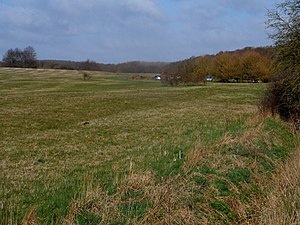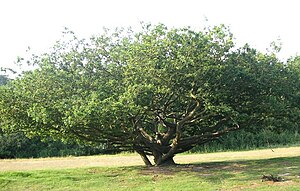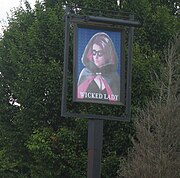Nomansland, Hertfordshire: Difference between revisions
No edit summary |
|||
| (One intermediate revision by the same user not shown) | |||
| Line 1: | Line 1: | ||
[[File:Nomansland Common.jpg|thumb|right|300px|Nomansland Common]] | [[File:Nomansland Common, Hertfordshire - geograph-3428612.jpg|thumb|right|300px|Nomansland Common]] | ||
'''Nomansland''' is a hamlet and a common in [[Hertfordshire]] to the south-west of [[Wheathampstead]] and north of [[Sandridge]]. The hamlet is a clutch of houses and a farm, the whole named after '''Nomansland Common''' (sometimes called "No Man's Land"). | '''Nomansland''' is a hamlet and a common in [[Hertfordshire]] to the south-west of [[Wheathampstead]] and north of [[Sandridge]]. The hamlet is a clutch of houses and a farm, the whole named after '''Nomansland Common''' (sometimes called "No Man's Land"). | ||
| Line 26: | Line 26: | ||
==History== | ==History== | ||
[[File:The Wicked Lady | [[File:The Wicked Lady - Nomansland.jpg|left|thumb|180px|The Wicked Lady]] | ||
Nomansland is so named as it was long disputed land. During the Middle Ages the common was the source of frequent disputes between St Albans Abbey and Westminster Abbey, both claiming it to be within their respective jurisdictions, and with the manors of [[Sandridge]] and [[Wheathampstead]] likewise. The common is now divided between the parishes of Wheathampstead and Sandridge. In 1427 the abbot of Westminster erected a gallows there, which the servants of St Albans Abbey promptly destroyed. In 1428 a shepherd died on the common and the Vicar of Sandridge claimed the body for burial, but the men of Wheathampstead spirited the corpse away and buried it in their churchyard. In 1429 a jury agreed that both abbeys should share grazing rights and beat the boundaries according to their own claims. | Nomansland is so named as it was long disputed land. During the Middle Ages the common was the source of frequent disputes between St Albans Abbey and Westminster Abbey, both claiming it to be within their respective jurisdictions, and with the manors of [[Sandridge]] and [[Wheathampstead]] likewise. The common is now divided between the parishes of Wheathampstead and Sandridge. In 1427 the abbot of Westminster erected a gallows there, which the servants of St Albans Abbey promptly destroyed. In 1428 a shepherd died on the common and the Vicar of Sandridge claimed the body for burial, but the men of Wheathampstead spirited the corpse away and buried it in their churchyard. In 1429 a jury agreed that both abbeys should share grazing rights and beat the boundaries according to their own claims. | ||
Latest revision as of 16:42, 29 February 2020

Nomansland is a hamlet and a common in Hertfordshire to the south-west of Wheathampstead and north of Sandridge. The hamlet is a clutch of houses and a farm, the whole named after Nomansland Common (sometimes called "No Man's Land").
Nomansland Common

Nomansland Common is a piece of open land and scrubby woodland bisected by Ferrers Lane. The land to the south of the Lane is open grassland and is mostly used for dog walking and picnics. The land to north has grown up into woodland, and is punctuated by biking trails, but also contains, as is well known to local children, what is believed to be "the best climbing tree in the world".
Ferrers Lane is named after Lady Katherine Ferrers, said to have been the notorious highwaywoman, the Wicked Lady, from whom the Wicked Lady pub at the end of the lane is named.
Nomansland Common is also popular for the local radio-controlled aeroplane and helicopter flying club known as Nomansland Flyers which can normally be seen flying most commonly on a Saturday from lunch time up to 7 pm. The permitted flying times are as follows;[1]
- Electric models: Daylight hours
- Internal combustion models: Mon-Sat 10 am-7 pm
Geology
Geologically, the Common is part of the Harpenden Dry Valley. Geologists reckon that in the last ice age a glacier dammed a river which then flowed from Dunstable south of Sandridge into St Albans Vale, creating a lake. When the dam melted and water drained away, it left the thin, stony soil still found on the common today.
Nomansland has, throughout its history, been recognised for uniquely poor soil quality for agricultural purposes, although flint axe heads suggest that the common may have been cleared for grazing as long ago as 4000 BC. During the Second World War attempts were made to plant crops on the Common, but the Common yielded less than half of the produce per unit area as other arable land, despite heavy use of fertilisers. After the end of the War, the land was re-seeded as grass and returned to recreational use.
Sport on the Common
On 8 June 1833 Simon Byrne, the famous bare knuckle fighter, died after a particularly bloody encounter at Nomansland which lasted no fewer than 99 rounds. His opponents, the seconds, and the referee were all convicted of manslaughter, and the local magistrates were censured for not stepping in to prevent the fight.
Thomas Coleman (1796-1877), a noted trainer, made steeplechasing into a spectator sport rather than just an individual challenge. The first such steeplechase in England was held at Nomansland in 1830. The sport rapidly became popular, although Coleman himself discontinued the steeplechase in 1839 when the Grand National was started.
Cock fighting, though illegal, is believed to have been carried on at the common until the early part of the 20th century.
History

Nomansland is so named as it was long disputed land. During the Middle Ages the common was the source of frequent disputes between St Albans Abbey and Westminster Abbey, both claiming it to be within their respective jurisdictions, and with the manors of Sandridge and Wheathampstead likewise. The common is now divided between the parishes of Wheathampstead and Sandridge. In 1427 the abbot of Westminster erected a gallows there, which the servants of St Albans Abbey promptly destroyed. In 1428 a shepherd died on the common and the Vicar of Sandridge claimed the body for burial, but the men of Wheathampstead spirited the corpse away and buried it in their churchyard. In 1429 a jury agreed that both abbeys should share grazing rights and beat the boundaries according to their own claims.
In 1460 the Second Battle of St Albans was fought on Bernards Heath, and part of the conflict (the flight of the Yorkists) occurred on the common. In the 18th century, cannonballs and 25 skeletons were recovered from the site, and are believed to date from the battle.
In the 17th century brigands and footpads preyed upon travellers around the common, the most famous of which was the "Wicked Lady", a highwaywoman claimed, after her death, to have been Lady Katherine Ferrers of Markyate. Ferrers Lane, which runs through the middle of the common, takes its name from her, and her exploits are the subject of two films of that name. Also, a pub on the edge of the common is called The Wicked Lady.